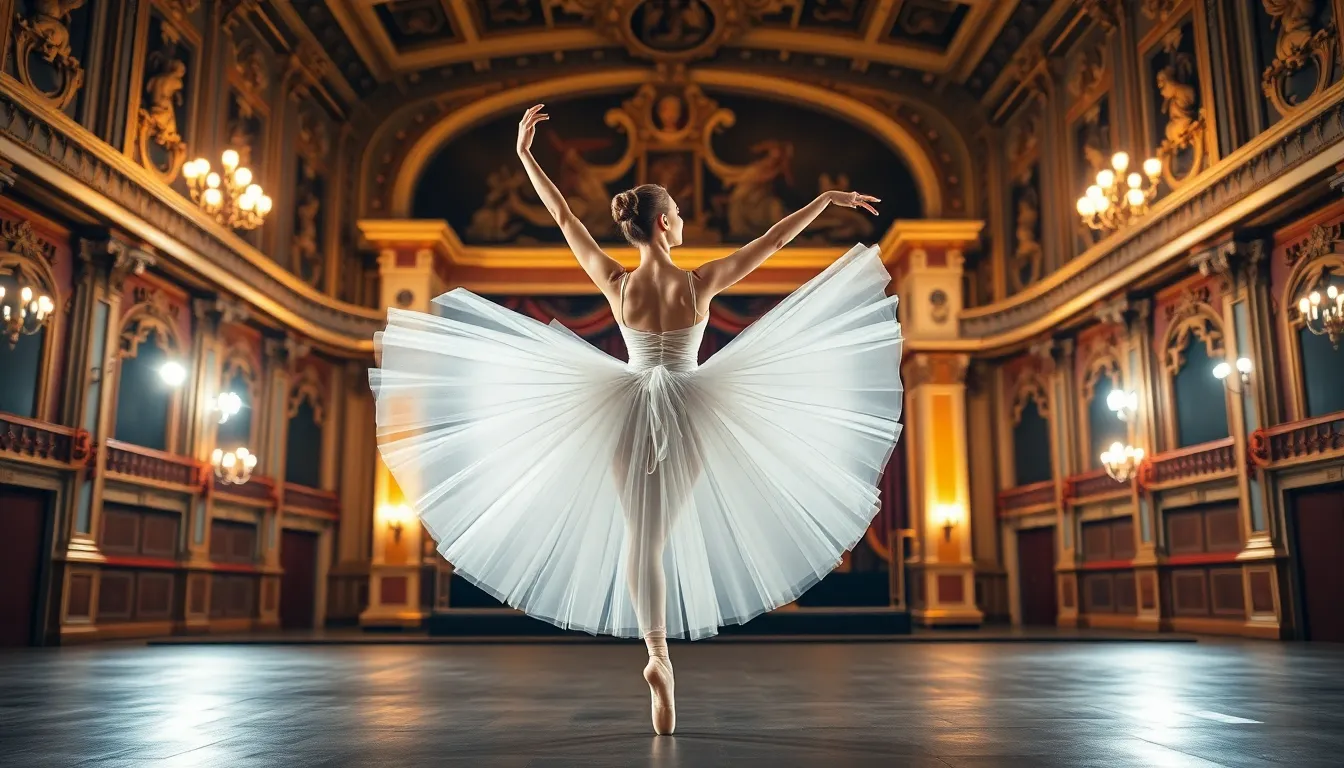Table of Contents
ToggleClassical ballet music is like the secret sauce in a gourmet dish—without it, the whole experience just falls flat. Imagine dancers gliding across the stage, their movements perfectly synchronized to the enchanting melodies of Tchaikovsky or Prokofiev. It’s not just music; it’s a magical spell that transforms a simple performance into an unforgettable spectacle.
Overview of Classical Ballet Music
Classical ballet music forms the backbone of ballet performances, influencing both mood and choreography. Encompassing various musical styles, this genre often features orchestral compositions characterized by lyrical melodies and intricate harmonies. Notable composers like Tchaikovsky and Prokofiev crafted timeless scores that perfectly complement the nuances of ballet.
Ballet music serves multiple purposes. First, it establishes the emotional landscape of the dance, guiding the audience through the story being portrayed. Second, it aids dancers in timing their movements, maintaining synchrony with the music’s rhythm and tempo. Each composition contains unique sections, allowing for a dynamic range that enhances the visual artistry of dance.
Popular ballets such as “Swan Lake” and “Romeo and Juliet” illustrate how music influences the overall narrative. Tchaikovsky’s “Swan Lake” employs haunting melodies that evoke themes of love and tragedy, while Prokofiev’s score for “Romeo and Juliet” incorporates passionate motifs that reflect the drama of the storyline.
Different composers bring distinct elements to classical ballet music. For instance, Stravinsky’s “The Firebird” incorporates folkloric themes and rhythmic complexity, while Adams’ contemporary works explore minimalist motifs. Each piece contributes uniquely to the ballet repertoire, expanding the emotional and artistic potential of the performance.
Classical ballet music retains a timeless quality that continues to resonate with audiences. Its capacity to evoke feelings and enhance storytelling makes it an essential aspect of the ballet experience. With evolving styles and innovative compositions, the connection between music and dance remains vital in the world of ballet.
Historical Background

Classical ballet music has a rich history that intertwines with the development of dance itself. This genre has its roots in the Renaissance period when courtly dances began incorporating music composed specifically for performance.
Origins of Classical Ballet Music
Renaissance composers like Giovanni Gabrieli began experimenting with orchestral arrangements. They fused vocal and instrumental music, creating early forms of ballet music. Italy played a crucial role in this development, with the Balletto emerging as a distinct form that featured simple melodies paired with dance.
French courts adopted these styles, leading to the emergence of the ballet de cour in the 16th and 17th centuries. Music became increasingly sophisticated, incorporating more complex harmonies. Significant composers of this time included Jean-Baptiste Lully, whose works helped define the sound of early ballet.
Evolution Through the Ages
In the 18th century, composers such as Christoph Willibald Gluck began transforming ballet music by emphasizing dramatic expression. The focus shifted toward narrative storytelling, allowing the music to guide the dance more effectively.
The 19th century introduced a watershed moment in ballet music with composers like Tchaikovsky, whose scores for ballets such as “Swan Lake” and “The Nutcracker” elevated the emotional depth of performances. By the 20th century, Igor Stravinsky’s innovative works added rhythmic complexity and modernist elements, further pushing the boundaries of orchestral sound.
Contemporary composers continue this tradition, blending traditional techniques with modern influences, ensuring that classical ballet music evolves with the art form.
Key Composers in Classical Ballet Music
Classical ballet music features several key composers whose works significantly shaped the genre. Their contributions enhance the ballet experience through rich melodies and intricate compositions.
Pyotr Ilyich Tchaikovsky
Tchaikovsky stands out as one of the most influential figures in classical ballet music. He composed iconic works like “Swan Lake,” “The Nutcracker,” and “Sleeping Beauty.” His ability to evoke deep emotions through music captures the essence of storytelling in dance. Melodies crafted by Tchaikovsky are memorable, often intertwining with the choreography to express love, longing, and tragedy. His orchestration blends lush harmonies with vivid themes, further enhancing dramatic ballet narratives. Tchaikovsky’s scores continue to resonate with audiences, solidifying his legacy in ballet history.
Igor Stravinsky
Stravinsky revolutionized the classical ballet landscape with innovative compositions. His work “The Firebird” introduced new rhythmic structures and folkloric elements. The collaboration with dancers and choreographers brought a fresh perspective to ballet music. Stravinsky’s piece “The Rite of Spring” challenged traditional forms, creating a groundbreaking shift in musical presentation. Complex rhythms and unexpected dissonances define his style, pushing the boundaries of orchestration. Stravinsky’s influence remains profound, impacting both ballet and contemporary music.
Sergei Prokofiev
Prokofiev made significant contributions to ballet music, producing works that reflect his unique musical voice. Notable ballets such as “Romeo and Juliet” and “Cinderella” showcase his ability to blend lyrical melodies with dramatic narratives. His rhythmic vitality and bold orchestration create engaging soundscapes that elevate the dancers’ performance. Prokofiev’s music often features playful motifs and emotional depth, allowing the audience to connect with the story. His innovative approach continues to inspire contemporary choreographers and composers alike.
Iconic Ballet Scores
Classical ballet features several iconic scores that define the genre and elevate the art of dance.
The Nutcracker
Tchaikovsky’s “The Nutcracker” stands out as a beloved holiday classic. The enchanting score, famous for its whimsical melodies, includes pieces like the “Dance of the Sugar Plum Fairy” and “Waltz of the Flowers.” Each number captures the magic of the story, inviting audiences into a fantastical world filled with wonder. Dancers interpret these musical motifs through graceful movements that reflect the narrative’s charm. The ballet’s popularity ensures its enduring presence in theaters, solidifying its status in the ballet repertoire.
Swan Lake
Tchaikovsky’s “Swan Lake” has become synonymous with classical ballet. This dramatic score features haunting themes, particularly in the iconic “Swan Theme.” The music perfectly matches the narrative, illustrating the struggle between love and betrayal. Each act introduces new motifs that correspond with the characters’ emotions, enhancing the overall storytelling. The score’s lyrical quality allows dancers to express deep feelings, captivating audiences and showcasing the power of music in ballet.
Romeo and Juliet
Prokofiev’s “Romeo and Juliet” brilliantly captures the essence of Shakespeare’s tragedy. The score showcases a blend of lyrical melodies and dramatic motifs that reflect the story’s passion and conflict. Pieces like “Dance of the Knights” highlight the tension between the feuding families. Different sections of the music correspond with pivotal moments, guiding dancers in their portrayal of love and fate. Prokofiev’s work remains a staple in the classical ballet canon, illustrating how music can elevate storytelling in dance.
Impact of Classical Ballet Music on Dance
Classical ballet music plays a critical role in shaping dance performances. It influences the emotional tone, guiding both dancers and audiences through the narrative. Composers like Tchaikovsky and Prokofiev create soundscapes that resonate with the movements of the dancers, resulting in a seamless connection between music and choreography.
Tchaikovsky’s works exemplify this impact. His scores for “Swan Lake” and “The Nutcracker” create vivid pictures that enhance storytelling. Prokofiev’s compositions, including “Romeo and Juliet,” evoke deep emotions through a blend of lyricism and drama, helping dancers convey the characters’ journeys effectively.
Different styles emerge from various composers. Stravinsky contributes rhythmic complexity, as seen in “The Firebird” and “The Rite of Spring.” His innovative approaches challenge traditional structures, allowing for new interpretations in ballet choreography. Contemporary composers continue to expand this foundation, merging traditional techniques with modern motifs.
The cultural significance of classical ballet music further enriches the genre. Historical context reveals its growth from Renaissance court dances to elaborate orchestral compositions. This evolution melds artistic expression with cultural storytelling, ensuring the art form remains relevant.
Music not only supports technical execution but also elevates the emotional experience. Dancers rely on the music’s rhythm for timing, creating a unified performance that captivates audiences. Thus, everyone involved—from composers to dancers—plays a vital role in this intricate partnership, fostering a compelling experience that transcends the stage.
Classical ballet music is more than just an accompaniment; it’s a vital element that breathes life into performances. The synergy between music and dance creates an immersive experience that captivates audiences and enhances storytelling. Through the rich legacies of composers like Tchaikovsky, Prokofiev, and Stravinsky, the genre continues to evolve while maintaining its emotional depth.
As ballet adapts to contemporary influences, the enduring power of classical music remains a cornerstone of this art form. The intricate melodies and dynamic rhythms not only guide dancers but also resonate with audiences, ensuring that classical ballet music will always hold a special place in the hearts of those who appreciate the beauty of dance.




